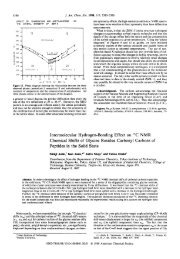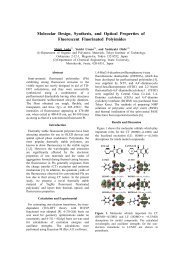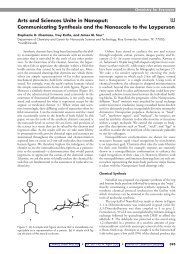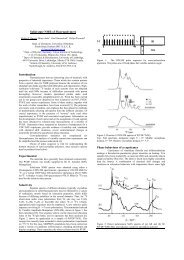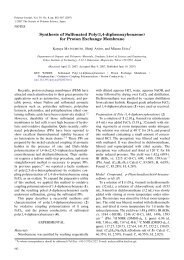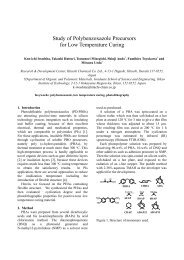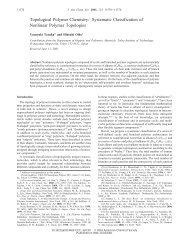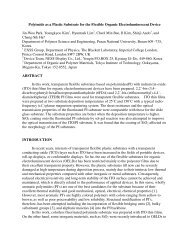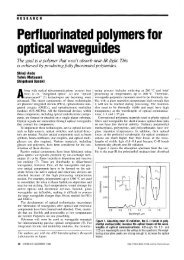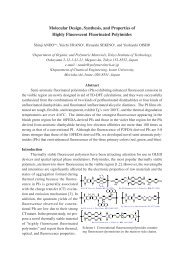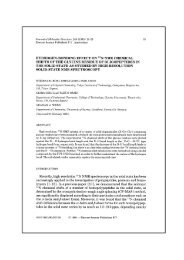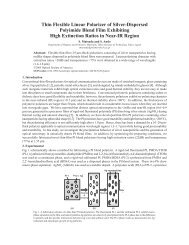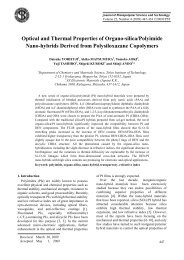Organic/inorganic-polyimide nanohybrid materials for advanced ...
Organic/inorganic-polyimide nanohybrid materials for advanced ...
Organic/inorganic-polyimide nanohybrid materials for advanced ...
You also want an ePaper? Increase the reach of your titles
YUMPU automatically turns print PDFs into web optimized ePapers that Google loves.
where K p is the molecular packing coefficient, α λ the wavelength-dependent molecular polarizability of a repeating unit,and V vdw the van der Waals volume of a repeating unit. The wavelength dispersion of refractive indices in the visibleregion is usually estimated by Abbe number (ν) which is defined as equation (2).(2)Transparent and colorless <strong>polyimide</strong>s 15 with high refractive indices and high Abbe numbers are preferable <strong>for</strong> thermallystable lens applications. We have demonstrated that the density functional theory (DFT) calculations using the B3LYPhybrid functional can reproduce the wavelength-dependent refractive indices of eight-six organic compounds with highaccuracy. 16-19 As shown in Fig. 1, the experimental Abbe numbers (ν exp ) are well reproduced by the calculated values(ν cal ) with the square correlation factor (r 2 ) of 0.978 as accompanied by the good correlation between the experimental(n exp ) and calculated refractive indices (n cal ). 19 These relations clearly indicate that the DFT is a useful tool to predict theoptical properties of novel polymers suitable to specific applications.70Calculated Ref. Index at 589 nm1.71.61.51.41.31.3 1.4 1.5 1.6 1.7Experimental Ref. Index at 589 nm1010 20 30 40 50 60 70Fig. 1 Relationships between the experimental and calculated (a) refractive indices and (b) Abbe numbers <strong>for</strong> eighty-sixorganic compounds. The refractive indices are the values at 589 nm.Conventional polymers could be endowed with high refractive indices by introducing substituents having higher molarrefraction and lower free molecular volumes. In particular, sulfur-containing substituents are one of the most promisingcandidates. Terui et al. have reported that a PI derived from 3,3’,4,4’-biphenyltetracarboxylic dianhydride (sBPDA) andbis(4-aminophenyl)disulfide exhibit a very high n of 1.698 with a low birefringence of 0.09. 20 Scheme 1 shows thesulfur-containing PIs designed and synthesized by Liu, Ando, Ueda et al. 21-31 The optical absorption spectra and therefractive index dispersions of the PIs derived from APTT diamine and s-BPDA dianhydride are shown in Figs. 2 and 3.The PI (3SDEA-APTT) with the highest sulfur content of 23.2 % shows the highest n of 1.761 at 632.8 nm. This is oneof the highest values in high-n polymers.R=s-BPDAS,SO 2NOOa-BPDAmDPSDASR,OONOR'ODPASnScheme 1 Sulfur-containing fully- and semi-aromatic <strong>polyimide</strong>s (PIs) exhibiting high refractive indices.Calculated Abbe Number, ,CHDA CBDAS3SDEAS6050403020R'=SSDASSExperimental Abbe NumberS3SDASS, SAPTTSSS2SPDA,,,SSSSSAPSTAPDBTSO 2BADPSSSSProc. of SPIE Vol. 7213 72130B-2



